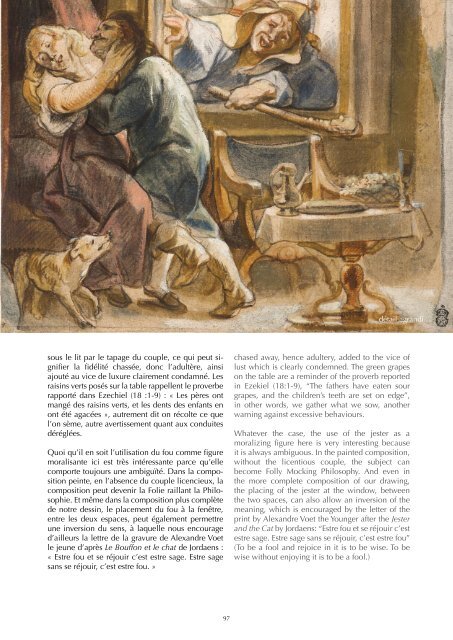You also want an ePaper? Increase the reach of your titles
YUMPU automatically turns print PDFs into web optimized ePapers that Google loves.
détail agrandi<br />
sous le lit par le tapage du couple, ce qui peut signifier<br />
la fidélité chassée, d<strong>on</strong>c l’adultère, ainsi<br />
ajouté au vice <strong>de</strong> luxure clairement c<strong>on</strong>damné. Les<br />
raisins verts posés <str<strong>on</strong>g>sur</str<strong>on</strong>g> la table rappellent le proverbe<br />
rapporté dans Ezechiel (18 :1-9) : « Les pères <strong>on</strong>t<br />
mangé <strong>de</strong>s raisins verts, et les <strong>de</strong>nts <strong>de</strong>s enfants en<br />
<strong>on</strong>t été agacées », autrement dit <strong>on</strong> récolte ce que<br />
l’<strong>on</strong> sème, autre avertissement quant aux c<strong>on</strong>duites<br />
déréglées.<br />
Quoi qu’il en soit l’utilisati<strong>on</strong> du fou comme figure<br />
moralisante ici est très intéressante parce qu’elle<br />
comporte toujours une ambiguïté. Dans la compositi<strong>on</strong><br />
peinte, en l’absence du couple licencieux, la<br />
compositi<strong>on</strong> peut <strong>de</strong>venir la Folie raillant la Philosophie.<br />
Et même dans la compositi<strong>on</strong> plus complète<br />
<strong>de</strong> notre <strong>de</strong>ssin, le placement du fou à la fenêtre,<br />
entre les <strong>de</strong>ux espaces, peut également permettre<br />
une inversi<strong>on</strong> du sens, à laquelle nous encourage<br />
d’ailleurs la lettre <strong>de</strong> la gravure <strong>de</strong> Alexandre Voet<br />
le jeune d’après Le Bouff<strong>on</strong> et le chat <strong>de</strong> Jordaens :<br />
« Estre fou et se réjouir c’est estre sage. Estre sage<br />
sans se réjouir, c’est estre fou. »<br />
chased away, hence adultery, ad<strong>de</strong>d to the vice of<br />
lust which is clearly c<strong>on</strong><strong>de</strong>mned. The green grapes<br />
<strong>on</strong> the table are a remin<strong>de</strong>r of the proverb reported<br />
in Ezekiel (18:1-9), “The fathers have eaten sour<br />
grapes, and the children’s teeth are set <strong>on</strong> edge”,<br />
in other words, we gather what we sow, another<br />
warning against excessive behaviours.<br />
Whatever the case, the use of the jester as a<br />
moralizing figure here is very interesting because<br />
it is always ambiguous. In the painted compositi<strong>on</strong>,<br />
without the licentious couple, the subject can<br />
become Folly Mocking Philosophy. And even in<br />
the more complete compositi<strong>on</strong> of our drawing,<br />
the placing of the jester at the window, between<br />
the two spaces, can also allow an inversi<strong>on</strong> of the<br />
meaning, which is encouraged by the letter of the<br />
print by Alexandre Voet the Younger after the Jester<br />
and the Cat by Jordaens: “Estre fou et se réjouir c’est<br />
estre sage. Estre sage sans se réjouir, c’est estre fou”<br />
(To be a fool and rejoice in it is to be wise. To be<br />
wise without enjoying it is to be a fool.)<br />
97















